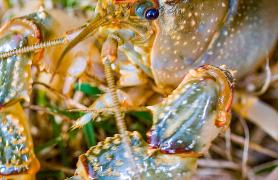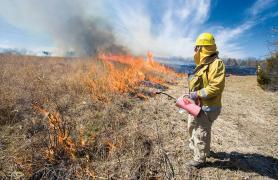No matter where you look in Missouri’s Bootheel, the mighty Mississippi River has left its mark. The river’s influence on the landscape of Missouri’s southeast region is even more significant when one realizes the area used to be an ocean, said MDC Systems Ecologist Molly Sobotka.
“Since then, the Mississippi has at various times flowed over and through much of the flatlands of the Bootheel, which means most of the soil was deposited here by the river,” she said.
At one time, the river flowed through 1.65 million acres of the area, creating a massive swamp. It pushed sediment across the land, creating natural hills in the floodplain and large areas of sandy ground. The history of the river’s influence on the Bootheel is what has created the diverse plants and habitat found there. Now, levees protect many of those areas, creating spaces for agriculture and cities, but the remaining wetlands across the Bootheel are still regulated by the flood cycle. Floods flush water, nutrients, sediment, and all kinds of insects and macroinvertebrates into the wetlands.
Fish spawn during floods, and their eggs and offspring often end up in flooded areas where they take advantage of the growing plankton and invertebrates for food. A rich diversity of young fish thrive in the shallow flooded spaces.
These larval stage crappie, bluegill, alligator gar, buffalo, gizzard shad, and other native species use the flooded spaces. The vegetation slows the water and provides places to hide from predators.
“When they’re larger, they’ll move into the deeper spaces of the river,” Sobotka said.
Above the water, eagles and herons feast year-round on the abundance of fish. The river also acts as a major migratory flyway for songbirds and waterfowl throughout the spring and fall. These birds rely on the river’s offerings, including seeds and fruits from riparian plants and an abundance of semiaquatic invertebrates like mayflies, to fuel their trips.
“In spring or summer, you can whack a tree branch and send mayflies swarming, then they’ll kind of settle back down to the branch,” Sobotka said. “The mayflies are a great source of protein for birds migrating along the river.”
While not found in the main channel of the river, amphibians seek safe-haven in adjacent floodplain wetlands and lakes. Five of Missouri’s 12 salamander species thrive in the Bootheel. The western lesser siren lives in the sluggish ditches, sloughs, and swamps. By day, it hides under submerged plants, and then forages at night for crayfish, aquatic insects, and worms.
The river has influenced the spread of plants, as well, dispersing seeds across the region. Trees that “like to have their feet wet” do well in the riparian corridor of the mighty river, Sobotka said.
“We have some very cool, flood-adapted species — like bald cypress, water tupelo, and cottonwood trees — that grow along the river and can be massive,” she said.
Bottomland Hardwood Forests
Imagine thick stands of some of the oldest trees in the state. The soil is rich and the trees are accustomed to surviving seasons of continually wet, flooded ground. The canopy is filled with pinoak, bur oak, swamp white oak, sycamore, cypress, and tupelo that darken the light beneath. These old trees can reach more than 100 feet high and 2 feet in diameter.
“One of the richest habitats in these low areas are the bottomland hardwood forests,” said MDC Resource Forester Ross Glenn.
“These are remnants of what the entire region once was, when it was more than 90 percent covered in these forests, with sandy prairies, bottomland lakes, sloughs, and marshes interspersed within the forest,” Glenn said.
The understory is relatively open, with woody vines and shrubs like spicebush, pawpaw, and buckeye. Cavities in the large, aged trees provide shelter for wildlife, including the region’s rare swamp rabbit, which uses snags and downed logs throughout the forest.
Less than 10 percent of the Bootheel lowlands have forest cover. Looking at what southeast Missouri once was helps to understand what is today, Glenn said. The sections of major habitat types — the St. Francis Floodplain, Little River Basin, Mississippi River Meander Belt, and elevated sandy ridges like Malden Ridge, Sikeston Ridge, and Sand Plains — should all be considered when examining the Bootheel’s bottomland forests, he said.
Trees in the St. Francis Floodplain include sweetgum, cypress, elm, water tupelo, and a variety of oak species on slightly higher elevations. The Little River Basin is a longbroad clay-filled area that extends down through the center of the lowlands, flanked by sandy ridges and once dominated by swamps, backwater sloughs, bottomland forest, and open water marshes. Sweetgum, ash, elm, maple, and a variety of oak trees are found there.
The Mississippi River Meander Belt is where the Mississippi River carved through the land over the last several hundred years. Elm, cottonwood, sweetgum, ash, and cypress trees thrive there.
The elevated sandy ridges of Malden Ridge, Sikeston Ridge, and Sand Plains rarely flood and the sandy soils play a major role in which plants survive. Forests in these higher areas look like the upland areas of the state, filled with sweetgum, oaks, elm, hickory, and dogwoods.
Sandy Prairies
Southeast Missouri conjures thoughts of swamps and bottomland hardwoods, but not necessarily prairie habitats. However, slight variations of elevations and the right soil make a completely different Bootheel habitat — the sand prairie.
Sand prairie is rare in Missouri. The 200-acre Sand Prairie Conservation Area (CA) in Scott County is one of the last remnants of sand-filled land. At 330–340 feet above sea level, it is one of the lowest spots in the state, but in the Bootheel, it’s one of the more “upland” areas. Sand prairies were created by the Mississippi and Ohio rivers, Sobotka said.
“As the rivers flooded, they pushed sediment out of their banks and into natural hills in the floodplain, creating large areas of sandy deposition,” she said. Due to the harsh, dry conditions and low soil fertility, few trees thrive in the sand prairies, according to Natural History Biologist Kevin Brunke, manager of Sand Prairie CA. However, in some places, sand prairies give way to sand savannahs and dry sand woodlands, where post oak, black jack oak, black hickory, and mockernut hickory dominate. Some species, like sand hickory, are only found in these sandy, sparsely forested habitats.
“Plants that thrive in sand prairies must endure the harsh conditions provided by easily eroded soils that are dry for much of the year,” Brunke said. “When you go to the sand prairie, it doesn’t look like a typical Missouri landscape. You’ll see split beard bluestem, tickseed coreopsis, eastern prickly pear, snout bean, dotted beebalm, and plains puccoon. These plants are up for the challenge of the less fertile soil.”
The prickly pear, typically thought of as belonging in deserts of the western U.S., thrives in the sand prairie. Plants like dotted beebalm and snout bean are restricted to these sandy habitats, causing them to be species of conservation concern.
Like sand-selective plants, wildlife in a sand prairie thrive for specific reasons. Many grassland birds, like eastern meadowlarks, dickcissels, northern harriers, and northern bobwhites use sand prairies, as do some species of conservation concern, like dusty hog-nose snakes, Illinois chorus frogs, and northern scarlet snakes. On warm spring nights, Illinois chorus frogs can be heard near wet swales in an otherwise sandy landscape.
MDC uses prescribed fire to help maintain the area’s biodiversity, Brunke said. Fire allows certain species to flourish while setting back other species that creep in where they don’t belong.
“Without fire, trees would also encroach on the prairies in some places, shading out many of the sun-loving species of native grasses and wildflowers,” he said. Just months after a prescribed fire, the native wildflowers and grasses on the area emerge lush and thicker than before. Managers also collect seeds from plants on the area for restoration efforts elsewhere.
Sand Prairie CA is one of the few remaining public sand prairie habitats. Many historical sand prairies are now being farmed. Center pivot irrigation systems allow successful farming of the sandy soils, while leaving the nonirrigated corners of fields available for prairie restoration. Game species like eastern cottontails and northern bobwhites can use these corners, forming an important partnership between farming and conservation, Brunke said. Also, the plant diversity in these dry, sandy corners provides excellent habitat for pollinators.
Wetlands
Each spring and fall, snow geese tornados — flocks of hundreds of thousands of snow geese — descend on the region’s wetlands to take advantage of the smorgasbord of marsh plants.
The Missouri Bootheel was once an expansive swampland, consisting of 1.65 million acres of bottomland forests and herbaceous swamp, said MDC Wetlands Ecologist Frank Nelson. The remaining tracts of wetland habitat — nearly 84,000 acres — span several MDC conservation areas, Big Oak Tree State Park, and Mingo National Wildlife Refuge, as well as private land enrolled in the Wetland Reserve Easement Program.
These wetlands are magnets for outdoor activities.
“Whether it’s hunting, fishing, birdwatching, or just enjoying the sights and sounds, there is always something to experience in a wetland, and it is likely going to be different from your last outing,” Nelson said.
Missouri’s wetlands are hotspots of natural diversity and top the list of locations with the most documented bird species, which reflects the diversity of other species as well.
Wild game, including deer and turkey, take advantage of the wetlands’ abundant food, cover, and water. Twice a year, songbirds, shorebirds, waders, waterfowl, rails, and others migrate to and through Missouri’s wetlands, stopping to rest and refuel for the next leg of their seasonal journey. During the summer months, a variety of songbirds, ducks, marsh birds, and wading birds use Missouri’s rivers, sloughs, and marshes to breed and raise their young.
“Below the water and under the leaf litter there are smaller, more cryptic creatures that also rely on these wet-dry habitats,” Nelson said. “Salamanders, frogs, snakes, and turtles rest and reproduce using a mosaic of wet and dry habitats in close juxtaposition.”
Periodically, through wet cycles, fish move into other wetland habitats and take advantage of the flooded bugs and leafy cover for food and refuge before moving back into adjacent rivers and streams. At an even more discrete and hard to discern scale, the base of the food chain is anchored by a host of terrestrial and aquatic invertebrates that move the ecological gears of decomposition and pollination.
“At the end of the day, these dynamic locations are a dizzying array of diversity, which is truly special,” Nelson said.
A River Still Runs Through It
Southeast Missouri’s rich legacy of habitat and wildlife diversity has changed over time. Despite levees and channels that drain excess water away from roads and fields, the mighty Mississippi River continues to influence the region.
“It’s a love-hate relationship with the flooding,” Sobotka said. “On one hand, the flooding does cause real hardship to us in so many ways. On the other, as I look out across all that mass of water, I can’t deny a little excitement for the equally massive amount of life that is abounding underneath.”
That life, in the form of fish, plant, and amphibian species crossing what would normally be a hard boundary, as well as nutrients spreading throughout the area, will trickle into richer soil and an even greater abundance of wildlife to enjoy.


















Also In This Issue


And More...
This Issue's Staff
Editor - Angie Daly Morfeld
Associate Editor - Larry Archer
Staff Writer - Bonnie Chasteen
Staff Writer - Heather Feeler
Staff Writer - Kristie Hilgedick
Staff Writer - Joe Jerek
Art Director - Cliff White
Designer - Les Fortenberry
Designer - Marci Porter
Photographer - Noppadol Paothong
Photographer - David Stonner
Circulation - Laura Scheuler






















